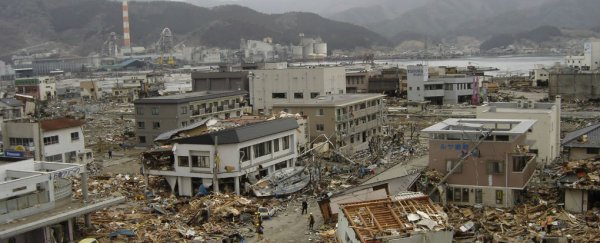Four years ago, much of Japan's northeastern coastline was ravaged by the magnitude 9.0 Tōhoku earthquake and tsunami.
The disaster saw large-scale power outages, three moderate meltdowns at the Fukushima Dai-ichi power plant, more than 18,000 people killed, and it caused damages to the country estimated to be worth about US$34 billion.
Japan hopes a similar crisis can be averted in the event of another mega earthquake. In the wake of the incident, it began planning for large-scale sea walls to be constructed in the worst affected areas.
This $6.8 billion plan will link 440 sections of wall together to form a 400-kilometre-long (250-mile) wall that in some places will stand more than 12-metres-tall. That's about the size of a four-storey building.
Needless to say, it's a controversial plan. In addition to being pretty grim to look at and obscuring ocean views, the Associated Press reports that opponents say the walls will damage marine ecosystems, prove detrimental to fisheries, and will actually do little to protect residents in these areas, who are still advised to move to higher ground in the event of an earthquake rather than waiting to see if the walls will hold.
Japan formerly had protective walls in the region, many of which were built in the 1930s following a large tsunami. One of these stood up reasonably well against the 2011 tsunami. Most, however, did not.
"…the evidence for their effectiveness is flimsy. True, Fudai, a village sheltering behind a giant concrete shield, escaped unscathed in 2011. But in the city of Kamaishi a $1.6 billion breakwater, listed in the 'Guinness Book of Records' as the world's largest, crumbled on impact. Nearly 90 percent of existing seawalls along the northeast coast suffered a similar fate."
"There is simply no guarantee that seawalls will stop every single tsunami," Nobuo Shuto, an engineer at Tohoku University, told The Economist back in 2014.
According to a report in the Associated Press, "the paradox of such projects, experts say, is that while they may reduce some damage, they can foster complacency. At least some of the 18,500 people who died or went missing in the 2011 disasters failed to heed warnings to escape in time."
In addition to making people too reliant on technology, it might encourage developers to build in areas where they shouldn't.
"The safest thing is for people to live on higher ground and for people's homes and their workplaces to be in separate locations. If we do that, we don't need to have a 'Great Wall,"' Tsuneaki Iguchi, who was mayor of Iwanuma, a town inundated by the 2011 tsunami, told the Associated Press.
According to Reuters, Iguchi is pushing for an alternative idea "to plant mixed forests along the coasts on tall mounds of soil or rubble".
A forest wall wouldn't halt a tsunami, but it would help to slow down the speed of the waves, and could prevent debris from being washed back out to sea.
Right now, it seems like the concrete wall will win out. And it's easy to see why this might be a grudgingly popular option, especially for people who lived through the devastation of the tsunami. And maybe it's worth it, so long as it's carried out with adequate considerations for the environment.
If the walls do go ahead, hopefully they get covered with some awesome murals.
Sources: Associated Press, Reuters, The Economist
